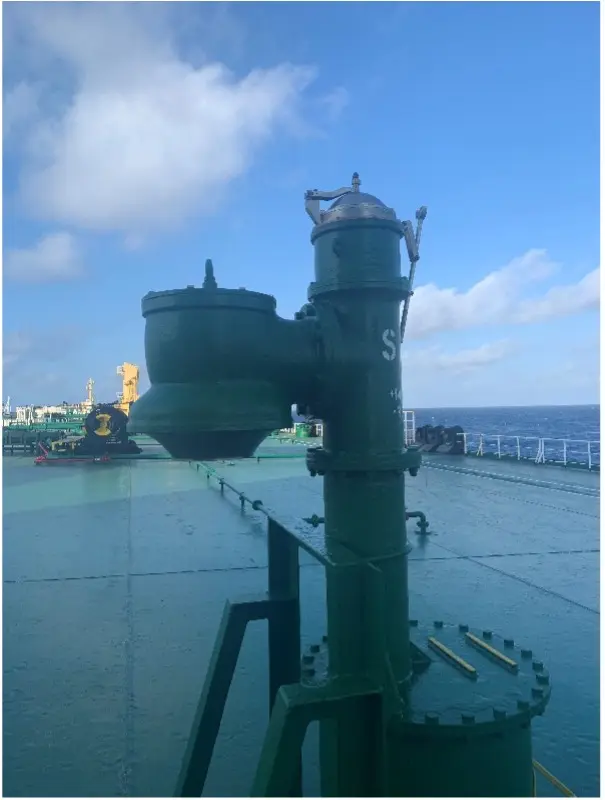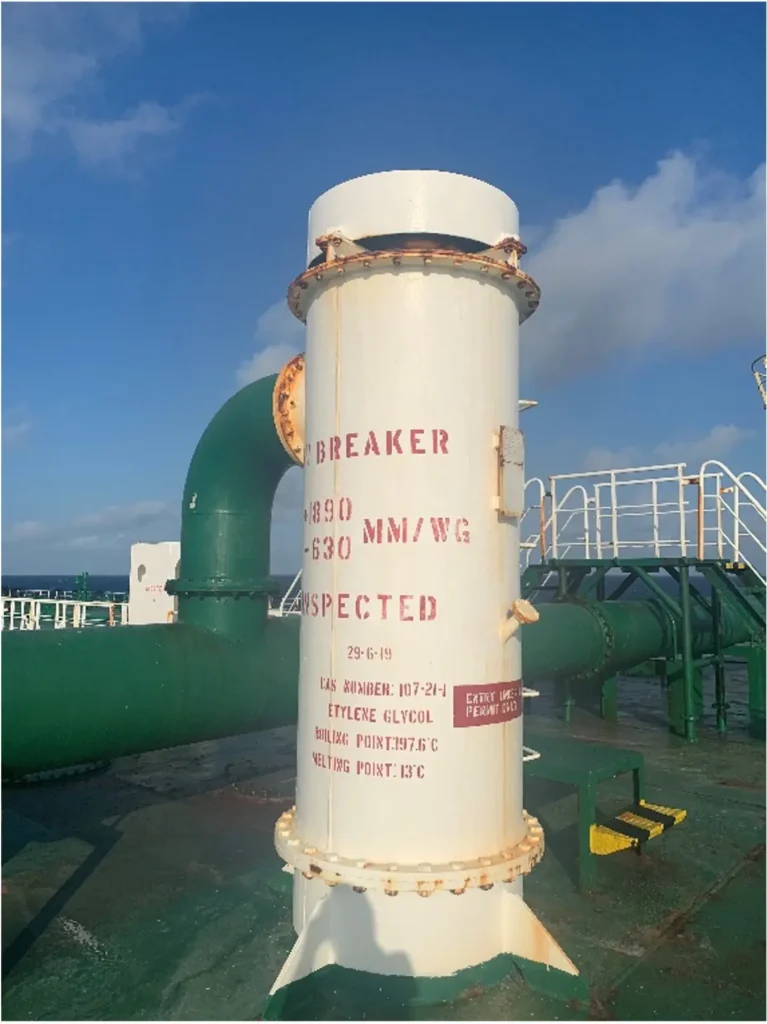Just like most of the equipment, tanks also have some limited pressure range to be followed for it not to be devastated. Excessive tank pressure and vacuum can surely cause serious problems or damage to the vessel’s structures. Generally, most of the tanks are normally designed to operate within the 200-1200 mmAq pressure range. Any variations outside this range should be taken seriously and considered abnormal.
PV valves and PV breakers on ships are safety devices to protect the tanks from excessive pressure and vacuum. When pressure or vacuum is not maintained inside the tanks, this will activate the PV valves and breakers, thus making the air and gas flow uncontrollable. Hydrocarbon vapors may escape to the deck and air may be drawn inside the tanks
This is why intensive attention must be given to tank pressures during loading, discharging, or even on sailing to avoid damage to the vessel’s structures. The normal pressure range inside the tank is easily achievable because of the large volume of inert gas inside the tank. Any fluctuations inside the tank will be noticed directly and the operator has enough time to take any necessary actions to maintain the pressure range.
What Is The Difference Between A PV Valve And A PV Breaker?
Although PV valves and PV breakers are both safety devices for the protection of overpressure and extreme vacuum, they too have differences in how they operate.
During loading and discharging operation, PV valves maintain the pressure and vacuum inside the tanks by venting. They are used to prevent any over or under-pressure on the tanks. Meanwhile, PV breakers operate on higher pressure settings than the PV valves. PV breakers open during an abnormal increase in pressure on cargo tanks when the loading rate exceeds the maximum rate capacity, resulting in pressure inside the tanks.
These two safety devices also prevent under pressure, they both open and draw air inside the tanks when the vacuum pressure exceeds -630 to -720 mmAq to avoid any tank deformation.
How Does A PV Valve Work?
Like most tanker ships, each tank has branches for the discharge of vapors into the mast riser during operations, purging, or gas freeing. The piping for the mast riser PV valve bypasses the mast riser shut-off valve. Moreover, the PV valve is normally set to open at a pressure lower than the liquid-filled PV breakers.

In vacuum cases, the PV valves are normally open at a vacuum slightly less or the same as the PV breakers. As the PV valve opens due to excessive vacuum, air will be drawn into the tanks. On the other hand, if the tank is exposed to extreme pressure, the PV valve will open and expel tank vapors into the atmosphere via the mast riser.
How Does A PV Breaker Work?
PV breakers are normally liquid-filled and are fitted on the inert gas deck main line. This device is installed and designed to ensure relief of tank pressure and vacuum. In most cases, they operate when:
- Cargo is to be discharged at the maximum rated capacity of the pumps and suddenly the inert gas blower fails, creating a negative pressure of more than -630 mmAq.
- During loading operations where tanks are to be filled at maximum capacity by the cargo and all outlets are left shut and/or the mast riser fails, creating a positive pressure of more than 1890 mmAq.
Operations of PV Breakers
There are three ways the PV breakers operate:
- Normal operation– during normal operation, the relatively low inert gas pressure in the inert gas main line that has around 100 -200 mmAq will cause a slight displacement of water inside the PV breakers. In this manner, the water lock ensures that the normal pressure will not spread on the deck.
- Over-pressure operation– the tanks will be over-pressurized due to some accidental closure of valves, the cargo filling rate is higher than the venting of the gas rate, and/or any failure of the control system. Once the overpressure setting is reached, the vapors inside the tank will push through the water in the PV breakers until it opens and releases the excess vapors along with the water. In addition, the PV breakers open up before the deck seal reaches its sealing limit.
- Vacuum operation– due to some circumstances like the cargo discharge rate being higher than the gas supply rate and/or any reduction in ambient temperature, a vacuum condition will develop inside the tanks. Through this, PV breakers will open up, drawing air inside along with the sealing water.

Use Of Antifreeze In PV Breaker
PV breakers work on the principle of a water lock. This device operates at a required pressure if the amount of liquid is filled at the correct level and density. Normally, an ethylene glycol/freshwater mixture or any recommended oil from the manufacturer is used to prevent freezing in low-temperature areas.
Moreover, pay attention to any corrosion inside, evaporation, ingress of seawater, and condensation for this will cause the abnormal operation of the PV breakers. These situations should be taken seriously and must be rectified accordingly.
Blowout of PV breakers
Worst case scenario, PV breakers tend to blow out on overpressure and vacuum, and this is very dangerous because this creates flammable gas mixtures on deck or inside the tanks. There are only two possible ways of a blowout, a pressure blowout or a vacuum blowout.
A pressure blowout is when a large amount of inert gas or hydrocarbon vapor is expelled on the deck due to over-pressurization, thus mixing it with the air on deck and being harmful to the crew surrounding it. Meanwhile, a vacuum blowout is when the air enters the tanks and could create a flammable mixture of air and hydrocarbon gases.
Causes Of Excessive Tank Pressure And Vacuum
Excessive tank pressure and vacuum can be caused by a variety of factors. One common cause is the failure of pressure and vacuum relief valves, which can lead to an increase in pressure or vacuum beyond the normal range.
Other causes include the failure of inert gas systems, which can lead to a loss of gas in the tank and a corresponding increase in pressure or vacuum, and the failure of cargo pumps or other mechanical equipment, which can also cause fluctuations in tank pressure.
In addition, extreme weather conditions, such as strong winds or waves, can also cause changes in tank pressure and vacuum. It is important to regularly monitor and maintain tanks and their associated equipment to prevent excessive pressure and vacuum, which can potentially damage the vessel and create hazardous situations.
PV Valve and PV Breaker: Pressure And Alarm Settings
PV valves and PV breakers tend to open on certain operating ranges for pressure and vacuum. These are their setting accordingly:
- In overpressure cases, PV breakers open higher than the PV valve. Normally, PV breakers are set to open at 1760-1890 mmAq where the tank vapor will be expelled to the deck.
- Meanwhile, PV valves open on a pressure setting of more or less 1420-1500 mmAq which releases the tank vapors to the mast riser and then to the atmosphere.
- For vacuum cases, PV valves have slightly more or the same pressure settings as the PV breakers for them to open. They both have more or less -630 to -720 mmAq pressure settings before they open and draw air into the tanks.
- Alarm settings are set to:
- High-pressure alarm set point: 1278 mmAq – 1300 mmAq
- Low-pressure alarm set point: 200 mmAq
- Low-low pressure alarm set point: 100 mmAq
- Alarm settings setpoints are usually set by the SOLAS and are to be met by the ship’s crew.
Maintenance And Testing Of Pv Valves And Pv Breakers
Proper maintenance and testing of PV valves and PV breakers are essential to ensure their proper functioning and to prevent accidents on board ships. PV valves and PV breakers should be regularly inspected and tested to ensure that they are in good working condition and capable of relieving pressure and vacuum as required.
This may involve visual inspections, functional testing, and the replacement of worn or damaged parts. It is important to follow the manufacturer’s recommended maintenance schedule and procedures to ensure that the PV valves and PV breakers are properly cared for.
Regular testing and maintenance can help to identify and resolve any issues before they become serious problems and can help to ensure the safe operation of the vessel.
Regulations And Standards For Pv Valves And Pv Breakers On Ships
There are several regulations and standards that apply to the use and maintenance of PV valves and PV breakers on ships. These regulations and standards help to ensure the safe operation of the vessel and protect against the risks associated with excessive tank pressure and vacuum.
International Maritime Organization (IMO) regulations and the International Convention for the Safety of Life at Sea (SOLAS) establish minimum requirements for the design, construction, testing, and maintenance of PV valves and PV breakers on ships.
In addition, national and regional regulations may also apply, and vessel operators need to be familiar with and comply with these requirements. Proper compliance with regulations and standards can help to ensure the safe operation of the vessel and protect against the risks associated with tank pressure and vacuum.
Conclusion
To conclude, during cargo operations on tanker vessels, we all know that they are loaded in a closed environment that we call tanks. Unfortunately, for this to happen, vapors/inert gas need to flow in or out of the tanks to avoid over-pressurization and/or extreme vacuum. This is why PV valves and PV breakers are fitted on the tanks and inert gas branch lines as safety valves to avoid undesirable damage to the tank’s structures when pressure and vacuum exceed the limits.
PV valves and PV breakers help the exchange of air, vapor, and inert gas inside the tanks in any scenario. But it is also essential to keep the tank’s pressure on the desired settings to avoid any blowout of PV breakers that may result in any harm to the crew and to the environment.
- Types of Gas Carriers as per IGC Code – April 22, 2025
- Wind-Assisted Propulsion Systems (WAPS): A Game Changer for Maritime Decarbonization – February 6, 2025
- 10 Boat Salvage Yards in California – January 25, 2025




